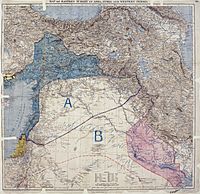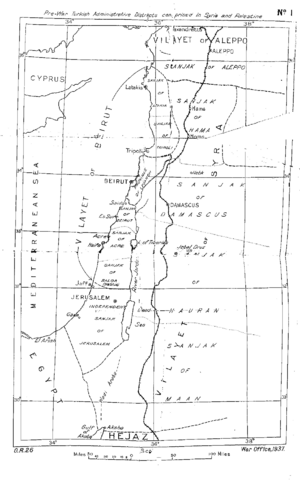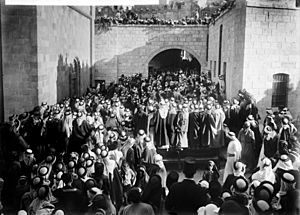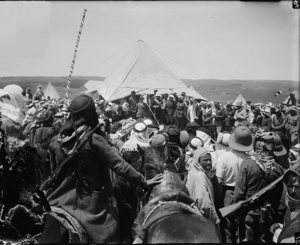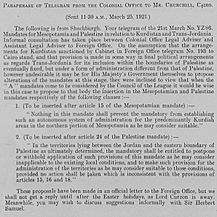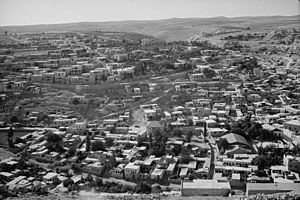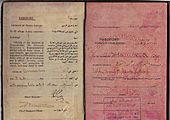Emirate of Transjordan facts for kids
Quick facts for kids
Emirate of Trans-Jordan
|
|||||||||
|---|---|---|---|---|---|---|---|---|---|
| 1921–1946 | |||||||||
|
Flag
(1928–1939) |
|||||||||
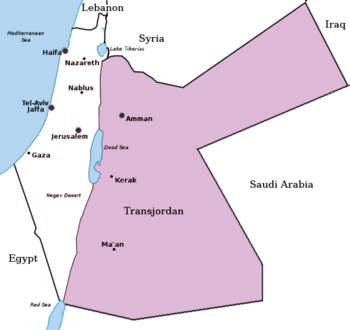
The region administered by the Emirate
|
|||||||||
| Status | League of Nations Mandate administered under the Mandate for Palestine | ||||||||
| Capital | Amman | ||||||||
| Official languages | Arabic | ||||||||
| Government | Absolute monarchy | ||||||||
| Emir | |||||||||
|
• 1921–1946
|
Abdullah I | ||||||||
| Resident | |||||||||
|
• 1921
|
Albert Abramson | ||||||||
|
• 1921
|
T. E. Lawrence | ||||||||
|
• 1921–1924
|
St John Philby | ||||||||
|
• 1924–1939
|
Henry Fortnam Cox | ||||||||
|
• 1939–1946
|
Alec Kirkbride | ||||||||
| Historical era | Interwar period | ||||||||
| March 1921 | |||||||||
| 11 April 1921 | |||||||||
|
• Independence announcement
|
25 April 1923 | ||||||||
|
• Anglo-Transjordanian treaty
|
20 February 1928 | ||||||||
| 22 March 1946 | |||||||||
|
• Full independence
|
25 May 1946 | ||||||||
|
|||||||||
| Today part of | Jordan Saudi Arabia Iraq |
||||||||
|
In 1965, Jordan and Saudi Arabia exchanged some territory.
|
|||||||||
The Emirate of Transjordan was a British protectorate, which means it was a country protected and partly controlled by Britain. It was officially created on April 11, 1921. The Emirate later became fully independent in 1946.
After the Ottoman Empire lost World War I, the area of Transjordan was managed by Britain. For a short time, it was part of the Arab Kingdom of Syria. However, after a battle in July 1920, Transjordan became like a "no man's land."
In November 1920, Abdullah bin Hussein arrived in the region. In March 1921, he met with British officials at the Cairo Conference. They agreed that Abdullah would rule Transjordan. This would happen under the British Mandate for Palestine, but with its own self-governing system.
The Hashemite family ruled Transjordan. They also ruled Mandatory Iraq and, for a time, the Kingdom of Hejaz. On May 25, 1946, the Emirate became the "Hashemite Kingdom of Transjordan." It gained full independence on June 17, 1946. In 1949, after adding the West Bank, it was renamed the "Hashemite Kingdom of Jordan," or simply Jordan.
How Transjordan Was Formed
Agreements That Shaped the Region
During World War I, Britain made two important agreements. From 1915 to 1916, letters were exchanged between Hussein bin Ali, Sharif of Mecca, an Arab leader, and Sir Henry McMahon, a British official. Britain promised to support Arab independence after the war if the Arabs revolted against the Ottoman Empire. This promise was for areas "east of the Jordan River."
At the same time, Britain and France made a secret agreement called the Sykes–Picot Agreement. This agreement divided the Middle East into areas of control for each country. Britain was given control over what is now southern Israel, Palestine, Jordan, and southern Iraq. The area that later became Transjordan was given to Britain.
Life Under Ottoman Rule
Before World War I, most of Transjordan was part of the Ottoman Empire. There was no single Ottoman district called Transjordan. People in the north often felt connected to Syria, while those in the south felt connected to the Arabian Peninsula.
A railway, called the Hejaz railway, was finished in 1908. This made it easier for people to travel for religious pilgrimages. It also helped the Ottoman Empire control the southern areas better.
The Arab Revolt and a New Kingdom
During World War I, the Arab Revolt took place in Transjordan. Arabs, with help from British officer T. E. Lawrence, fought against the Ottoman Empire. This revolt helped defeat the Ottomans and break up their empire.
In March 1920, the Arab Kingdom of Syria was declared in Damascus. It was led by Faisal bin Hussein and included most of what would become Transjordan.
How the Emirate Was Established
After France ended the Kingdom of Syria, Transjordan was left without a clear ruler. In August 1920, the British decided not to fully control Transjordan. Instead, they sent political officers to advise local leaders.
In November 1920, Abdullah, the brother of King Faisal, arrived in the region with his army. By March 1921, he had taken control of most of Transjordan without a fight.
Transjordan and Palestine
In early 1921, British officials discussed how Transjordan fit into the Mandate for Palestine. They decided that Transjordan was part of the mandate area. However, it would have a different administration. This was to keep Britain's promise to support Arab independence in that region.
The Cairo Conference in March 1921 was important. British Colonial Secretary Winston Churchill gathered experts to discuss the Middle East. A key decision was to offer the throne of Iraq to Faisal. His brother, Abdullah, was offered the leadership of Transjordan. This was seen as fulfilling Britain's promises to the Arabs.
After more talks, Churchill and Abdullah agreed that Transjordan would be part of the Palestine mandate area. But it would be an Arab country separate from Palestine. It would not be part of the Jewish national home planned for west of the Jordan River. Abdullah was then made Emir of Transjordan in April 1921.
On March 21, 1921, Article 25 was added to the Mandate for Palestine. This article allowed Britain to "postpone or withhold" parts of the Mandate about Jewish settlement in Transjordan. This meant Transjordan would be excluded from those provisions.
The Emirate Begins
Abdullah officially set up his government on April 11, 1921. Britain managed the land west of the Jordan as Palestine. The land east of the Jordan was managed as Transjordan. Even though they were technically one mandate, they were treated as two separate areas.
In April and May 1923, Transjordan was given some independence. Abdullah became the ruler, and Britain slowly gave up control. They kept control over money, military, and foreign policy. This separation meant that the dream of a Jewish state on both sides of the Jordan River would not happen.
Defining the Borders
The southern border with Arabia was important for Transjordan. It needed access to the sea through the Port of Aqaba. The southern area of Ma'an-Aqaba was managed by Britain and claimed by the Kingdom of Hejaz. After the Saudi conquest of Hejaz in 1924–25, Abdullah's Transjordan officially took control of the Ma'an region.
The Negev region was added to Palestine in July 1922. Abdullah asked for the Negev to be part of Transjordan in 1922 and 1925, but his requests were denied.
The eastern border with Iraq was important for a planned oil pipeline. It was set in December 1922. France also transferred the District of Ramtha from Syria to Transjordan in 1921.
Population of Transjordan
In 1924, Britain estimated Transjordan's population to be around 200,000 people. About 10,000 were Circassians and Chechens. There were also about 15,000 Christians. Most of the remaining population were Muslim Arabs. By the early 1940s, the population was estimated to have grown to 300,000 to 350,000.
| Territory | Population | |
|---|---|---|
| Ajloun, including Irbid and Jerash | 100,000 | |
| Balqa', including Al-Salt, Amman and Madaba | 80,000 | |
| Al-Karak, including Tafilah | 40,000 | |
| Ma'an, Aqaba, and Tabuk | 10,000 | |
| Total | 230,000 | |
| Estimates by FitzRoy Somerset and Frederick Peake, March 14, 1921 | ||
Protecting the Emirate
The biggest threats to Abdullah's rule came from Wahhabi tribesmen from Najd (modern Saudi Arabia). These tribes often raided southern Transjordan. Abdullah's army was not strong enough to stop these raids alone. He had to ask for help from the British.
The British had a small air force base near Amman. This British military force was key in stopping the Wahhabi raids between 1922 and 1924. They also helped Abdullah put down local rebellions in Kura and by Sultan Adwan in 1921 and 1923.
Becoming a Kingdom
Power was slowly transferred to the Arab government in Transjordan. This started with Abdullah becoming Emir on April 1, 1921. His first government was formed on April 11, 1921. On May 25, 1923, Britain publicly recognized Transjordan as an independent government under Emir Abdullah. This was dependent on an agreement with Britain.
In 1927, a British official explained Transjordan's status. He said it was not part of Palestine. However, it was part of the area Britain managed under the Palestine Mandate. Special arrangements were made for Transjordan because of Britain's wartime promises to the Arabs.
The 1928 Treaty
In 1928, most administrative tasks were transferred to Transjordan. A new position, High Commissioner for Transjordan, was created. A treaty between Britain and the Emirate was signed on February 20, 1928. This treaty recognized Transjordan's independent government and set limits on its powers.
Even though Transjordan was now "nominally independent," Britain still had a military presence. They also controlled foreign affairs and some financial matters. Many Transjordanians were unhappy with this. They wanted a fully independent state. This led to a national conference on July 25, 1928, to discuss the treaty.
Full Independence in 1946
On January 17, 1946, the British Foreign Secretary, Ernest Bevin, announced that Britain planned to make Transjordan a fully independent country. The Treaty of London was signed on March 22, 1946. This treaty recognized Transjordan's full independence once both countries' parliaments approved it.
The League of Nations recognized Transjordan's upcoming independence on April 18, 1946. On May 25, 1946, Transjordan officially became the "Hashemite Kingdom of Transjordan." This happened when the ruling Emir was renamed "King" by the parliament. May 25 is still celebrated as Independence Day in Jordan. The British mandate officially ended on June 17, 1946. In 1949, the country's name was changed to the "Hashemite Kingdom of Jordan."
When King Abdullah asked to join the United Nations, his request was blocked by the Soviet Union. They said Transjordan was not "fully independent" of British control. This led to another treaty with Britain in March 1948, which removed all remaining restrictions on Transjordan's independence. However, Jordan did not become a full member of the United Nations until December 14, 1955.
See also
- Oultrejordain
- Transjordan (region)





